| dc.contributor.author | Bravo-Abad, Jorge | |
| dc.contributor.author | Joannopoulos, John D. | |
| dc.contributor.author | Soljacic, Marin | |
| dc.date.accessioned | 2013-02-06T16:57:14Z | |
| dc.date.available | 2013-02-06T16:57:14Z | |
| dc.date.issued | 2012-06 | |
| dc.date.submitted | 2012-03 | |
| dc.identifier.issn | 0027-8424 | |
| dc.identifier.issn | 1091-6490 | |
| dc.identifier.uri | http://hdl.handle.net/1721.1/76750 | |
| dc.description | This article contains supporting information online at www.pnas.org/lookup/suppl/doi:10.1073/pnas.1207335109/-/DCSupplemental | en_US |
| dc.description.abstract | Many of graphene’s unique electronic properties emerge from its Dirac-like electronic energy spectrum. Similarly, it is expected that a nanophotonic system featuring Dirac dispersion (two conical bands touching at a single point, the so-called Dirac point) will open a path to a number of important research avenues. To date, however, all proposed realizations of a photonic analog of graphene lack fully omnidirectional out-of-plane light confinement, which has prevented creating truly realistic implementations of this class of systems able to mimic the two-dimensional transport properties of graphene. Here we report on a novel route to achieve all-dielectric three-dimensional photonic materials featuring Dirac-like dispersion in a quasi-two-dimensional system. We further discuss how this finding could enable a dramatic enhancement of the spontaneous emission coupling efficiency (the β-factor) over large areas, defying the common wisdom that the β-factor degrades rapidly as the size of the system increases. These results might enable general new classes of large-area ultralow-threshold lasers, single-photon sources, quantum information processing devices and energy harvesting systems. | en_US |
| dc.description.sponsorship | National Science Foundation (U.S.) (Materials Research Science and Engineering Centers Program, award DMR-0819762) | en_US |
| dc.description.sponsorship | United States. Dept. of Energy (MIT S3TEC Energy Research Frontier Center, Grant DE-SC0001299) | en_US |
| dc.description.sponsorship | United States. Army Research Office (Institute for Soldier Nanotechnologies, under contract W911NF-07-D0004) | en_US |
| dc.description.sponsorship | Spain. Ministerio de Ciencia e Innovacion (Ramon-y-Cajal program, Grant RyC-2009-05489) | en_US |
| dc.language.iso | en_US | |
| dc.publisher | National Academy of Sciences (U.S.) | en_US |
| dc.relation.isversionof | http://dx.doi.org/10.1073/pnas.1207335109 | en_US |
| dc.rights | Article is made available in accordance with the publisher's policy and may be subject to US copyright law. Please refer to the publisher's site for terms of use. | en_US |
| dc.source | PNAS | en_US |
| dc.title | Enabling single-mode behavior over large areas with photonic Dirac cones | en_US |
| dc.type | Article | en_US |
| dc.identifier.citation | Bravo-Abad, J., J. D. Joannopoulos, and M. Soljacic. “Enabling Single-mode Behavior over Large Areas with Photonic Dirac Cones.” Proceedings of the National Academy of Sciences 109.25 (2012): 9761–9765. Web. | en_US |
| dc.contributor.department | Massachusetts Institute of Technology. Department of Physics | en_US |
| dc.contributor.mitauthor | Joannopoulos, John D. | |
| dc.contributor.mitauthor | Soljacic, Marin | |
| dc.relation.journal | Proceedings of the National Academy of Sciences of the United States of America | en_US |
| dc.eprint.version | Final published version | en_US |
| dc.type.uri | http://purl.org/eprint/type/JournalArticle | en_US |
| eprint.status | http://purl.org/eprint/status/PeerReviewed | en_US |
| dspace.orderedauthors | Bravo-Abad, J.; Joannopoulos, J. D.; Soljacic, M. | en |
| dc.identifier.orcid | https://orcid.org/0000-0002-7184-5831 | |
| dc.identifier.orcid | https://orcid.org/0000-0002-7244-3682 | |
| mit.license | PUBLISHER_POLICY | en_US |
| mit.metadata.status | Complete | |
